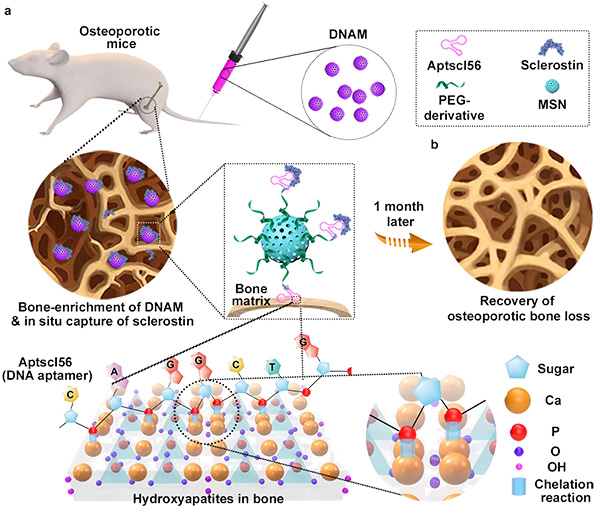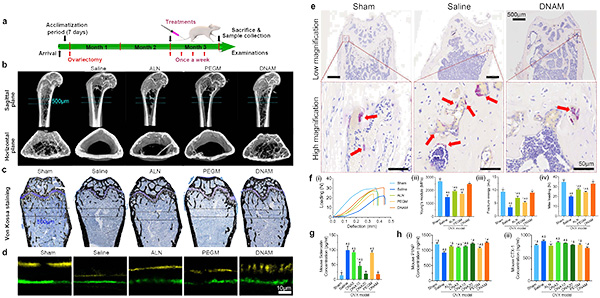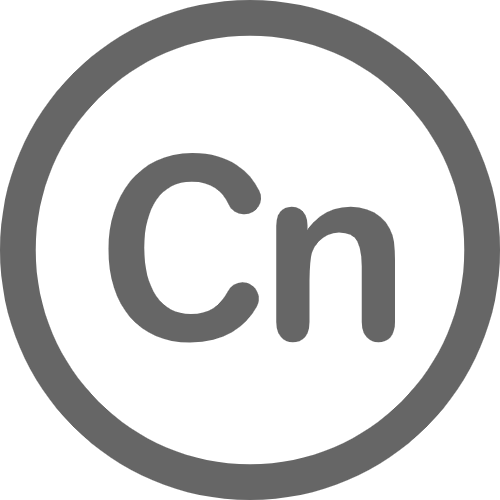Zhou Yongsheng's team from Peking University, School and Hospital of Stomatology, invented a novel bone-targeting nanomedicine for the treatment of osteoporosis
Recently, the team of Professor Yongsheng Zhou from the Department of Prosthodontics, Peking University, School and Hospital of Stomatology, published the latest research in the internationally renowned journal "Nano Today" (IF: 20.722), introducing a new type of nanomedicine for the treatment of osteoporosis.
Osteoporosis is one of the most common systemic musculoskeletal diseases, characterized by decreased bone mineral density and strength and increased fracture susceptibility. It is also strongly associated with the occurrence and development of oral diseases. For example, it increases the severity of periodontitis and the risk of jaw fracture; in addition, the commonly used bisphosphonates, such as alendronate (ALN), for osteoporosis treatment can cause jaw osteonecrosis. The nanomedicine achieves bone-targeted delivery, and efficiently treats osteoporosis by in situ capturing sclerostin. Moreover, it can also be of great help in the treatment of oral diseases, such as prosthodontics, oral implants and periodontal system treatment.
Bones are less vascularized than other organs, such as the liver, spleen, or kidneys. Nonspecific drug absorption and systemic high-dose/long-term use of conventional drugs, such as estrogen and alendronate (ALN), can lead to increased systemic toxicity and reduced therapeutic efficacy. The Wnt signaling pathway is closely related to osteogenesis. Sclerostin secreted by osteocytes can lead to the occurrence and development of osteoporosis by inhibiting the Wnt pathway. Therefore, reducing the amount of sclerostin in the body through various means has become an important goal in the treatment of osteoporosis.

DNAM synthesis, bone enrichment, and in situ capture of sclerostin for osteoporosis treatment
In that case, Yongsheng Zhou's team developed a nanomedicine. It is composed of an anti-sclerostin DNA aptamer layer, Aptscl56, and a PEGylated dendritic mesoporous silica nanoparticle (MSN) core. The nanoparticle core acts to protect the grafted Aptscl56 from rapid degradation by nucleases and renal filtration, extending its half-life in vivo. Aptscl56 molecules on the surface of DNAM exhibit a dual function. On the one hand, it can guide the bone-targeted delivery of nanomedicines. This is achieved through the interaction between the phosphate group in the Aptscl56 molecule and the calcium in bone hydroxyapatite. At the same time, Aptscl56 can efficiently capture surrounding sclerostin molecules in bone tissues, exhibiting a picomolar affinity.

DNAM efficiently rescues bone loss in an osteoporotic mouse model
More importantly, DNAM effectively reduced the amount of sclerostin in serum to normal levels, effectively improved the bone histomorphological parameters and mechanical properties of the femur, and restored the levels of serum bone turnover markers without evident systemic toxicity. Notably, DNAM was more effective than the "gold standard" drug alendronate. This study will contribute to the further development of oral nanomedicine for the efficient and convenient treatment of osteoporosis.
Dr. Yuting Niu and Dr. Yang Yang (Department of Prosthodontics) are the co-first authors. Prof. Yongsheng Zhou, Prof. Yunsong Liu (Department of Prosthodontics), and Prof. Yan Liu (Department of Orthodontics) are the corresponding authors. This project is supported by the National Natural Science Foundation of China, and the China Postdoctoral Science Foundation.
Yongsheng Zhou's research group has acquired many significant achievements in oral and maxillofacial tissue regeneration, especially in the research areas of stem cell biology, oral biomaterials and digital medical devices for prosthodontics. More than 110 research papers have been published in Chinese journals, and more than 150 research papers have been published in international authoritative journals, such as J Extracell Vesicles, Nano Today, Nano Energy, ACS Nano, Biomaterials, Bioactive Materials, Small, EMBO reports, etc.. In addition, more than 50 national patents have been approved. As the first completer, Prof. Yongsheng Zhou has won one first prize of Science and Technology Award of Chinese Stomatological Association and three Beijing Science and Technology Awards. He is responsible for more than 20 R&D projects, including projects from National Natural Science Foundation of China (including key projects), national key clinical specialty construction projects, and other provincial and ministerial research projects.
Link of this article: https://doi.org/10.1016/j.nantod.2022.101529
Nano Today 2022,Doi.org/10.1016/jD.nantod.2022.101529
last text: Researchers developed a novel carrier-free antitumor nano-vaccine for enhancing the immuno…
next text: Professor Yongsheng Zhou's Research Team Published An Innovative Bone Tissue Engineering R…






